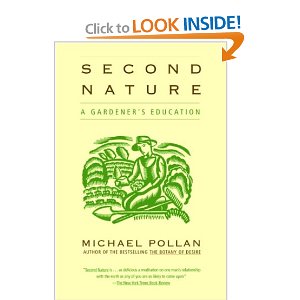 I have been wanting to read Michael Pollan’s new book, Cooked, particularly the chapter about fermenting, but it is checked out at the library. So I checked out his first book instead, Second Nature: A Gardener’s Education, which was published in 1993. Expect multiple blogs on this book.
I have been wanting to read Michael Pollan’s new book, Cooked, particularly the chapter about fermenting, but it is checked out at the library. So I checked out his first book instead, Second Nature: A Gardener’s Education, which was published in 1993. Expect multiple blogs on this book.
I like Michael Pollan because he’s a no nonsense guy. His basic rule about food is this: “Eat food, not too much, mostly plants.” He goes on to define food as basically anything your grandparents or great-grandparents would have recognized as food. In other words, not too many ingredients, processes, packaging materials or chemicals.
What immediately caught my attention with this book, though, was his account of his relationship to “the garden” as a product of the suburbs. I realized that I’ve mostly been reading work by farmers. Let’s face it, Barbara Kingsolver’s book Animal, Vegetable, Miracle, is about small-scale farming. A quarter acre plus chickens and turkeys is not a garden. Then there is my four-season guru, Eliot Coleman. The guy is hard core.
Pollan’s story of his first encounter with growing food is of sitting, at age four or five, in his favorite hiding place between the lilac hedge and the fence in their suburban backyard on Long Island. He looks down and sees a watermelon next to him. And he realizes that he grew that watermelon when he planted a seed from one he was eating back in the spring. He runs home bearing his watermelon, only to fall on the steps and smash it.
I can relate! My first experience with gardens was with the beds that ran along the back fence of our yard in Park Forest, Illinois. They were bordered with railroad ties. There is Super 8 footage of my little brother walking back and forth along those ties for hours. This is something we all did– our first balance beam! And more significantly, our first border.
In our suburban garden, my mother mostly planted flowers. However, one year she planted some carrots. When we discovered that the ground was “breathing,” we all came out to see the nest in the lawn and the baby bunnies. We promptly pulled up the young carrots and lay them next to the spot for easy access.
 My other memory of our garden is of the strawberries my mother planted along the east side of the yard. They usually ripened just in time for the last week or two of school in June. Those warm mornings we’d pick strawberries and cut them up on our cereal, then sit out at the redwood table on the stone patio and have breakfast before the bus arrived. I can think of nothing more pleasurable than those breakfasts.
My other memory of our garden is of the strawberries my mother planted along the east side of the yard. They usually ripened just in time for the last week or two of school in June. Those warm mornings we’d pick strawberries and cut them up on our cereal, then sit out at the redwood table on the stone patio and have breakfast before the bus arrived. I can think of nothing more pleasurable than those breakfasts.
These days, we are not kind to rabbits. My mother– well, I just can’t tell you what lengths her rage at rabbits in her flower garden has driven her to in recent years. My husband, however, has used a gun.
I am definitely more extreme than most gardeners I know. I live in the country now! The only vegetables I’ve purchased since May are a bag of onions, some new potatoes, and mushrooms. I am dedicated to eating from the garden as much and as long as we can.
It is good to remember that I grew up a suburban girl, in a place where “garden” mostly meant lawn, and marigolds, lilies and tulips, chives my mother could never dig out completely, mint, and, for several golden Junes, even strawberries.
The photo of strawberries is from a post on this date in 2009. Traditionally I pick strawberries today, my birthday, but this year they’re a little late…



HAPPY BIRTHDAY! Great memories.
Such sweet memories.
Did you see th